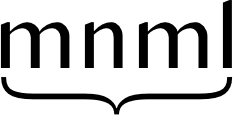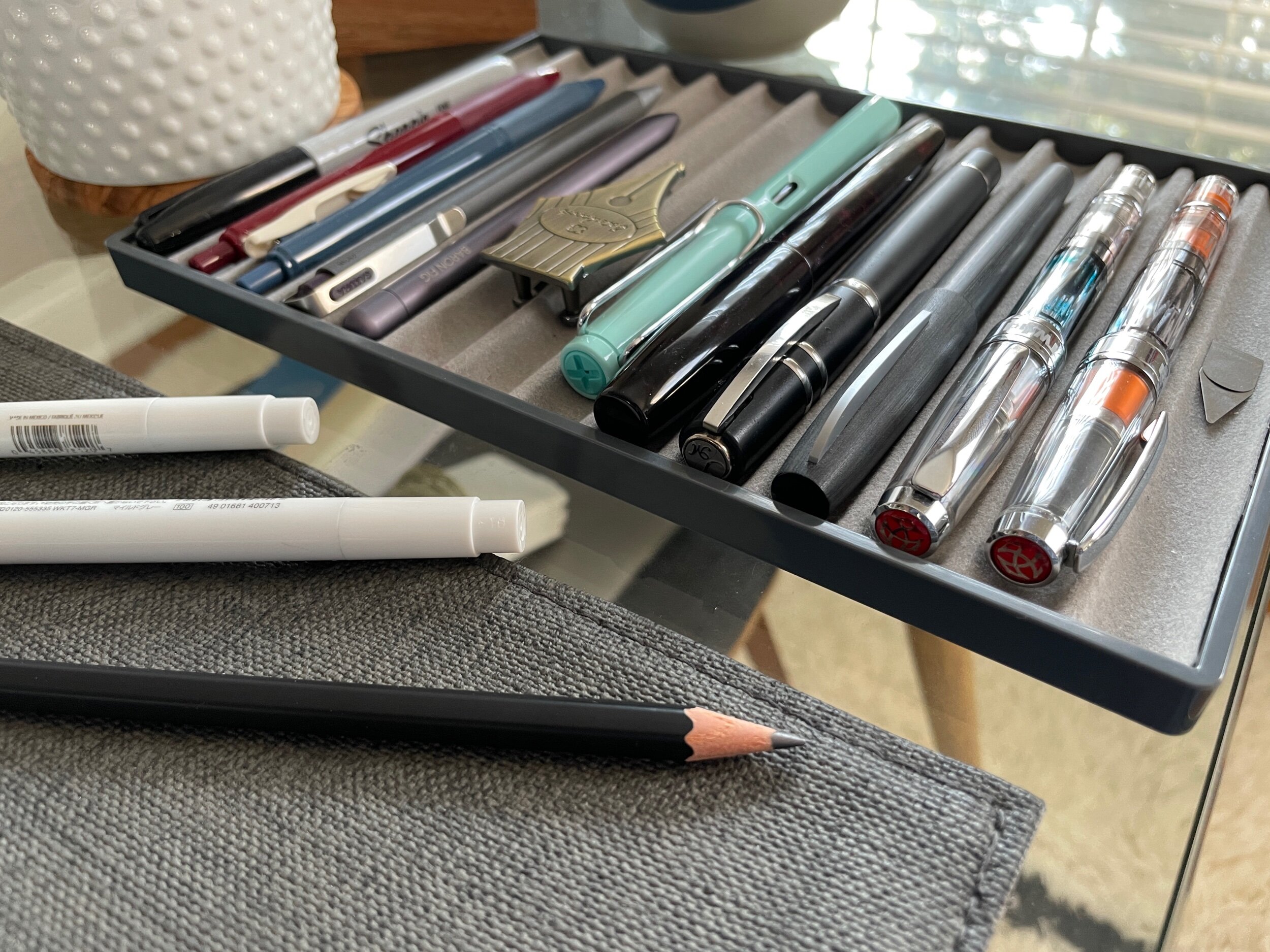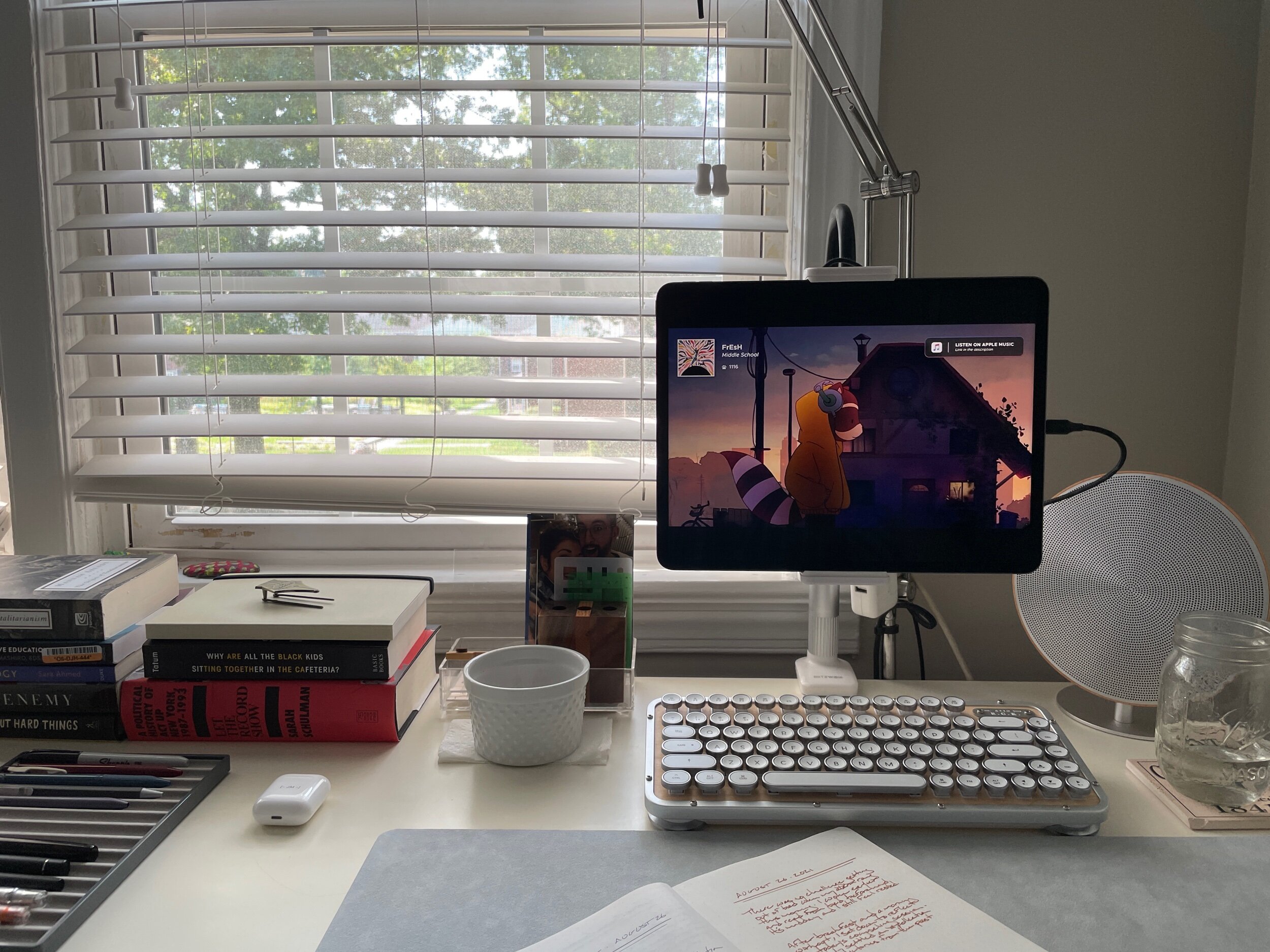Isn’t grey just wannabe black?
A pen friend — who shall remain anonymous — joked with me this week about my penchant for grey over true black inks. “Isn’t grey just wannabe black?” Pshaw.
I’m drawn to grey inks because they shade. So there’s personality in a grey ink. Personality balanced with letting your written words take central focus. Personality without the visual distraction of bright colors.
The goal for black inks is to fly underneath your attention. Your words are the only show when written in black ink. Grey inks participate, but minimally.
The swatch on my grey inks box
Dark grey inks. Function like black ink: easy to read, often quick to dry, and readily professional in work settings. Excellent for just about any writing task. My go-to hue for task management. Without a comparison, you might even mistake a dark grey for black — unless the ink shades prominently. They bring out the pop in bright accent colors.
Mid-grey inks. The bread-and-butter of grey ink user’s pool. Mid-toned greys take on noticeable undertones (e.g. warm greens, cool purples). Color without much distraction. My favorites shade loudly, while remaining dark enough for easy reading. Middling greys also expand your options for accent colors. Even a blue-black ink can be an accent color if the grey is written in an EF and the blue-black with a B.
Light-grey inks. Too light for day-to-day writing. Often quite dry, too. However, the misty quality of light-grey inks lends themselves well to untraditional uses. My favorite: as a highlighter. A light grey ink transforms a 1.5 mm stub or Pilot Parallel into a fun highlighter; like a Mildliner fountain pen. Dry ink can be a feature in addition to a bug.
Perhaps folks love blue-black inks for much the same reason I’m drawn to grey? Or prefer black inks for a reason I’m unfamiliar with?
This week’s Inked Tines update includes my most recent currently inked writing tools.
Toolset
Pens. The standout combo this week surprised me. The KACO Edge and a shimmerless Diamine Enchanted Ocean took to one another famously. Wet, true F line. The round F nib was excellent for quick meeting notes, brainstorm sessions, and commonplace notes (accent). 3/4 left.
TWSBI 580-AL (EF) — 3/5. One of my favorite EF nibs. Healthy feedback. Wet combo that reminds a true European EF line. Matter starts strongly green and dries a warm grey on CAL paper. Well-suited for every kind of writing I threw at it this week. Daily driver. Task management, scratch notes, commonplace notes (quotes).
TWSBI 580-AL (M Predator Hybrid) — 3/5. Wet. Wet enough for Verdigris to appear a blue-black on CAL and Tomoe River. Relegated to slower writing tasks to allow for longer dry times. EF side of nib worked well in a pocket notebook.
Mythic Aeschylus (F SIG) — 4/5. Nib creeper combination. Writing often started with a quick wipe to remove Cassis from the section. EF SIG kept Cassis one-dimensional. Wrote well. Bright enough for great accent notes. Wasn’t an exciting shade. May empty for a more joyful pen and ink pairing next week.
Lamy Safari (B) — Feed. Prominent shading and a B nib made this a popular pairing. A pairing worth repeating — and soon. Used mostly for journaling and commonplace accent work.
Visconti Homo Sapiens (F CI) — Empty. An opaque piston filler ensures you will be surprised when your pen runs empty. The dry Hisoku and torrential Visconti feed meet in the middle for a crisp writing experience. The grind makes this Combe best suited for deliberate writing: commonplace notes, journaling, and such.
Notebooks. Work bujo. Musubi Cosmo Air Light 83 (A5). Four new pages, ending on page 13. The school doth approach.
Two pages house a brainstorm list of session topics for a new strain of classes I’ve been asked to run. The last two pages are a calendar spread for scheduling when my advisors and I will run each topic.
Generating the 31 topics proved easier than I expected. I broke out four categories. Each category got a color family: earth tones, blues, purples, and teals.
CAL paper loves shading
Journal. Taroko Breeze (A5). Eight more pages spread across four entries. I reached for the Lamy and Toffee’s loud shading for half of this week’s pages. And I’m someone who enjoys rotating colors.
Three more pen and ink combos made up the remainder of this week’s journaling: the M side of Mr. Speer’s Predator Hybrid grind, Mr. Smith’s F cursive italic, and the KACO Edge.
Schmancy squiggles
I also landed on song lyrics to end my entries. Sia’s Little Black Sandals and The Frames’ Rise are classics.
… or just old songs
Commonplace. Elemental Paper Iodine (A5). I was targeted in the passages I pulled for my commonplace notebook. Five new pages.
The beauty of threading
Written dry. Three pens ran dry this week. Two croaked last weekend, before I transitioned into a new currently inked: the Visconti Homo Sapiens Blizzard and the Pelikan m805.
One pen from this week’s sextet ran dry, too. The Homo Sapiens Silver Age coughed up Friday afternoon. While brainstorming lesson topics. Victory.
Lastly, the Lamy is down to whatever ink remains in the feed. Toffee shades spectacularly in a B nib. The combo stood no chance against all my commonplace notes, school prep, and journaling.
Insert Xbox accomplishment sound
Newly inked. No need. I still had two blue ink choices after the Visconti kicked on Friday.
The collection
Incoming / new orders. A small haul of school-ish items arrived from JetPens arrived mid-week.
Little helpers
The Kyoei Ruler sports a 5mm grid that matches the grid in my Musubi notebook. And a beveled edge to prevent smudging. All the features a growing teacher needs.
The Kokuyo Karu tape cutter massages my compulsion towards even lines. It works well on narrow and full-width washi rolls.
Lastly, I added the Sakura Ballsign iD to my cart in a bid for free shipping. It’s not the smoothest writer — even for a gel pen. But the purple-black ink and disciplined 0.5mm line make it fun.
I use gel pens for my bullet journal indexes. Each month’s index list stays one color. September’s index in my work bullet journal: purple-black.
Outgoing / trades or sales. No movement on my collection of pens to sell. Nor on sending out my Parker Vacumatic for repair.
Currently reading and listening
Fiction. My good friend, Mark, gave me Martha Wells’ second book in the Murderbot Diaries, Artificial Condition. I read two chapters as I mellowed before bed Wednesday night.
Nonfiction. ’Twas a banner week. A week the gods of literacy will discuss over dinner — or at least morning snack. I finished three books. A book with a traditional academic outline can be a quick read and a close read.
Destined for my office bookshelf
I finished close-reading Dr. Tatum’s (2017) Why are all the Black kids sitting together in the cafeteria? on Tuesday. I’m struck by how much overlap there seems to be between critical theories’ focus on disrupting unjust practices and creating more just practices instead and Tatum’s call to “constructive action.”
Speaking of critical theories, I read Ngo & Kumashiro’s (2014) compilation of essays into anti-oppressive teaching on Wednesday and Thursday. It’s a collection of brave thinking. Mostly on ideas I’ve read from Kumashiro himself before.
Anna Sale’s (2021) book was lighter reading. Sale shares stories from a body of interviews she conducted. The argument is that listening is a key component to navigating challenging conversations. She suggests that listening better can build support networks. Gentle reading, but enjoyable.
And all just in time for the start of the school year.
Music. My partner teaches voice. The university’s semester started this week. They asked me for suggestions on vocalists who sound unique.
LP came to mind. I’ve been listening to LP’s powerhouse vocals in the days since. She is decidedly present. Loudly energetic. This is no background music.
And a small gallery of random pictures from this week. Thanks for making it to the end …














